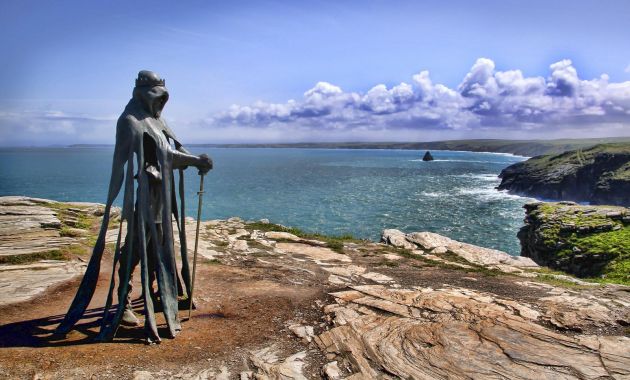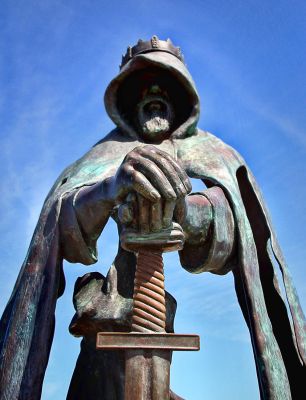8-foot-tall bronze sculpture of King Arthur on the cliffs of Tintagel
There could hardly be a more dramatic setting for a sculpture than the windswept edge of a rugged promontory, jutting into the Atlantic Ocean. Fitting just that bill are the cliffs of Tintagel Island, the perfect site for a haunting, larger-than-life sculpture of King Arthur.
Completed in 2016, the 8-foot-tall (2.4 metre) bronze sculpture was commissioned by English Heritage as part of their recent Tintagel Castle visitor experience. Along with other installations, the idea is to bring the history and legend of the site to life in a way that will inspire visitors. In the words of English Heritage's Head Curator:
You cannot understand Tintagel’s history without understanding how the legends shaped it. Our new interpretation explains this and places these legends within the context of Tintagel’s overall history and significance.
The King Arthur statue is the work of Welsh sculptor Rubin Eynon. Cast in solid bronze it took over six months to design, sculpt and cast the sculpture. The sheer size and weight of the statue meant that when it was installed in April of 2016 it was actually easier to fly it in by helicopter rather than lug it up and down the hundreds of steps over to the island.
The sculpture was given the title "Gallos", which is derived from the Cornish word for power. Despite having what appears to be the legendary sword, Excalibur, in hand and crown on head, English Heritage have been at some pains to neither confirm or deny whether the statue depicts King Arthur or not. The official line is that it represents not only the legend of Arthur but the royal heritage and historic importance of the site. However, for most it will be known as the King Arthur sculpture in Tintagel.
This vagueness probably stems from previous criticism of other installments at Tintagel Castle, most notably the carving of Merlin's face into the cliff face. A number of historians and Cornish nationalists were outraged by what they saw as the "Disneyfication" of such a profoundly historic site.
On the whole though, the Gallos sculpture has received a much more positive reception, and it is difficult to imagine why not. The sculpture is a work of beauty and in my opinion, despite its contemporary nature, complements its surrounds. In addition, in this place where legends mix with history it is hard to know what is "genuine" and what is not. For example the ruins of the castle itself where built long after Arthur's time by Richard, 1st Earl of Cornwall. He chose the location based on the legend and even had it styled to look older. Nor was Richard the last to impose his historic vision on the site; the Victorians left their mark with the construction of a castellated courtyard wall.







